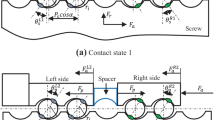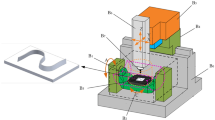Abstract
This paper proposes a novel comprehensive modeling method for deformation errors of different types of rolling joints in machine tools to improving the analysis efficiency. This method comprehensively considers the deformation of three types of rolling joints, i.e., linear guideway, ball screw and bearing, firstly from the perspective of analytical modeling. Two comprehensive models for deformation errors of all rolling joints in two types of motion systems of machine tools are established respectively with the method. The nonlinear interfacial characteristics at rolling joints and the geometric and stiffness coupling characteristics are considered. In order to study characteristics of the synthetical deformation error of rolling joints, a synthetical error model for a five-axis machine tool is developed. Several results and optimizations of the joints are carried out. The proposed method in this paper can effectively avoid the tedious finite element modeling in the traditional analysis process and improve the efficiency.
Similar content being viewed by others
References
M. S. Uddin, S. Ibaraki, A. Matsubara and T. Matsushita, Prediction and compensation of machining geometric errors of five-axis machining centers with kinematic errors, Precis. Eng., 33(2) (2009) 194–201.
R. Ramesh, M. A. Mannan and A. N. Poo, Error compensation in machine tools-a review, part I: geometric, cutting-force induced and fixture-dependent errors, Int. J. Mach. Tool Manuf., 40(9) (2000) 1235–1256.
R. Ramesh, M. A. Mannan and A. N. Poo, Error compensation in machine tools-a review, part II: thermal errors, Int. J. Mach Tool Manuf., 40(9) (2000) 1257–1284.
G. Chen and Q. Zheng, A rapid identification method for static stiffness of multi-axis CNC machine tools, Journal of the Balkan Tribological Aassociation, 22(3) (2016) 2771–2783.
X. Shi, H. Liu, H. Li, C. Liu and G. Tan, Comprehensive error measurement and compensation method for equivalent cutting forces, Int. J. Adv. Manuf. Tech., 85(1–4) (2016) 149–156.
T. L. Schmitz, J. C. Ziegert, J. S. Canning and R. Zapata, Case study: a comparison of error sources in high-speed milling, Precis Eng., 32(2) (2008) 126–133.
G. Chen, Y. Liang, Y. Sun, W. Chen and B. Wang, Volumetric error modeling and sensitivity analysis for designing a five-axis ultra-precision machine tool, Int. J. Adv. Manuf. Tech., 68(9–12) (2013) 2525–2534.
A. W. Khan and W. Y. Chen, Systematic geometric error modeling for workspace volumetric calibration of a 5-axis turbine blade grinding machine, Chin J. Aeronaut, 23(5) (2010) 604–615.
W. Tian, G. Yang, L. Wang, F. Yin and W. Gao, The application of a regularization method to the estimation of geometric errors of a three-axis machine tool using a double ball bar, Journal of Mechanical Science and Technology, 32(10) (2018) 4871–4881.
H. Li, Y. Li, W. Mou, X. Hao, Z. Li and Y. Jin, Sculptured surface-oriented machining error synthesis modeling for five-axis machine tool accuracy design optimization, Int. J. Adv. Manuf. Tech., 89(9–12) (2017) 3285–3298.
Z. Zhang, Z. Liu, L. Cai, Q. Cheng and Y. Qi, An accuracy design approach for a multi-axis NC machine tool based on reliability theory, Int. J. Adv. Manuf. Tech., 91(5–8) (2017) 1547–1566.
E. Chlebus and B. Dybala, Modelling and calculation of properties of sliding guideways, Int. J. Mach Tool Manuf., 39(12) (1999) 1823–1839.
B. Fang, L. Zhang, X. T. Qu and J. Zhao, Theoretical and experimental research of stiffness of angular contact ball bearing, Journal of Jilin University (Engineering and Technology Edition), 42(4) (2012) 840–844.
J. S. S. Wu, J. C. Chang, G. A. Tsai, C. Y. Lin and D. M. Ou, The effect of bending loads on the dynamic behaviors of a rolling guide, J. Mech Sci. Technol., 26(3) (2012) 671–680.
M. Rahmani and F. Bleicher, Experimental and analytical investigations on normal and angular stiffness of linear guides in manufacturing systems, Procedia CIRP, 41 (2016) 795–800.
M. Rahmani and F. Bleicher, Experimental and numerical studies of the influence of geometric deviations in the performance of machine tools linear guides, Procedia CIRP, 41 (2016) 818–823.
Y. Chen and W. Tang, Dynamic contact stiffness analysis of a double-nut ball screw based on a quasi-static method, Mech. Mach Theory, 73 (2014) 76–90.
M. Sanati, Y. Terashima, E. Shamoto and S. S. Park, Development of a new method for joint damping identification in a bolted lap joint, Journal of Mechanical Science and Technology, 32(5) (2018) 1975–1983.
O. Hiroyuki and E. Hayashi, Vibration of linear guideway type recirculating linear ball bearings, Journal of Sound and Vibration, 235(5) (2000) 847–861.
C. Y. Lin, J. P. Hung and T. L. Lo, Effect of preload of linear guides on dynamic characteristics of a vertical column-spindle system, Int. J. Mach Tool Manuf., 50(8) (2010) 741–746.
S. Xiang and Y. Altintas, Modeling and compensation of volumetric errors for five-axis machine tools, Int. J. Mach Tool Manuf., 101 (2016) 65–78.
J. Chen, S. Lin and X. Zhou, A comprehensive error analysis method for the geometric error of multi-axis machine tool, Int. J. Mach Tool Manuf., 106 (2016) 56–66.
S. Xiang and J. Yang, Error map construction and compensation of a NC lathe under thermal and load effects, Int. J. Adv. Manuf Tech., 79(1–4) (2015) 645–655.
J. S. Dhupia, A. G. Ulsoy, R. Katz and B. Powalka, Experimental identification of the nonlinear parameters of an industrial translational guide for machine performance evaluation, J. Vib. Control, 14(5) (2008) 645–668.
S. Y. Jiang and S. L. Zhu, Dynamic characteristic parameters of linear guideway joint with ball screw, Journal of Mechanical Engineering, 46(1) (2010) 92–99.
J. P. Urbanski, P. Koshy, R. C. Dewes and D. K. Aspinwall, High speed machining of moulds and dies for net shape manufacture, Mater. Design, 21(4) (2000) 395–402.
C. Yue, X. Liu and S. Y. Liang, A model for predicting chatter stability considering contact characteristic between milling cutter and workpiece, Int. J. Adv. Manuf. Tech., 88(5–8) (2017) 2345–2354.
N. Kardes and Y. Altintas, Mechanics and dynamics of the circular milling process, J. Manuf. Sci. E-T ASME, 129(1) (2007) 21–31.
C. Zhang, J. R. Zhang and P. Tang, Analysis of tooth profile and accumulative pitch errors of end-toothed disc and its tolerance development, Mech. Mach Theory, 122 (2018) 86–96.
C. Wan, R. Chen, S. Xue and Z. Wu, Development of a novel beam model and its dynamic characteristics, Mech. Adv. Mater. Struc., 22(5) (2015) 402–412.
D. E. Brewe and B. J. Hamrock, Simplified solution for elliptical-contact deformation between two elastic solids, Journal of Lubrication Technology, 99(4) (1977) 485–487.
Acknowledgments
The work was supported by the National Science and Technology Major Project (Grant No. 2013ZX04012032), 2017 Science and Technology Support Plan of Nanjing Jiangsu China (Grant No. 201701213), 2018 Science and Technology Support Plan of Yunnan China (Grant No. 2018IC30), the 2017 Open Fund Project of CAD/CAM University Engineering Research Center in Fujian Province (Grant No. K201707) and the National Key Research and Development Plan (No. 2019YFB2006402).
Author information
Authors and Affiliations
Corresponding author
Additional information
Cheng Zhang received the Ph.D. degree from Southeast University, China in 2019. He currently does research in AVIC NEIAS. His research interests include accuracy and dynamic characteristic analysis of machine tools.
Jianrun Zhang received the Ph.D. degree from Southeast University, China in 1997. He is currently a Professor in Southeast University. His research interests include structure dynamic design and optimization, vibration and noise control, accuracy analysis of machine tools.
Xiaojuan Sun received the Ph.D. degree from Southeast University, China in 2014. She is currently a Lecturer in Taiyuan University of Science and Technology. Her research interests include structure dynamic design and optimization, vibration and noise control.
Rights and permissions
About this article
Cite this article
Zhang, C., Zhang, J. & Sun, X. Comprehensive modeling method for deformation errors of different types of rolling joints in motion systems and its application in machine tools. J Mech Sci Technol 34, 4695–4710 (2020). https://doi.org/10.1007/s12206-020-1027-1
Received:
Revised:
Accepted:
Published:
Issue Date:
DOI: https://doi.org/10.1007/s12206-020-1027-1




